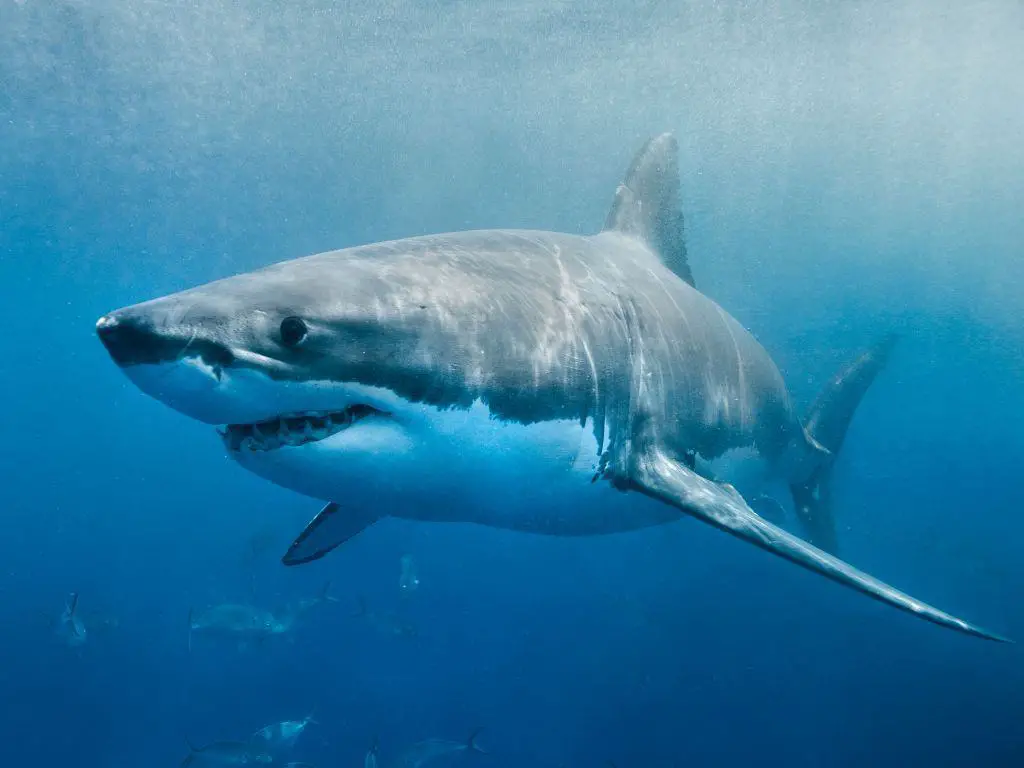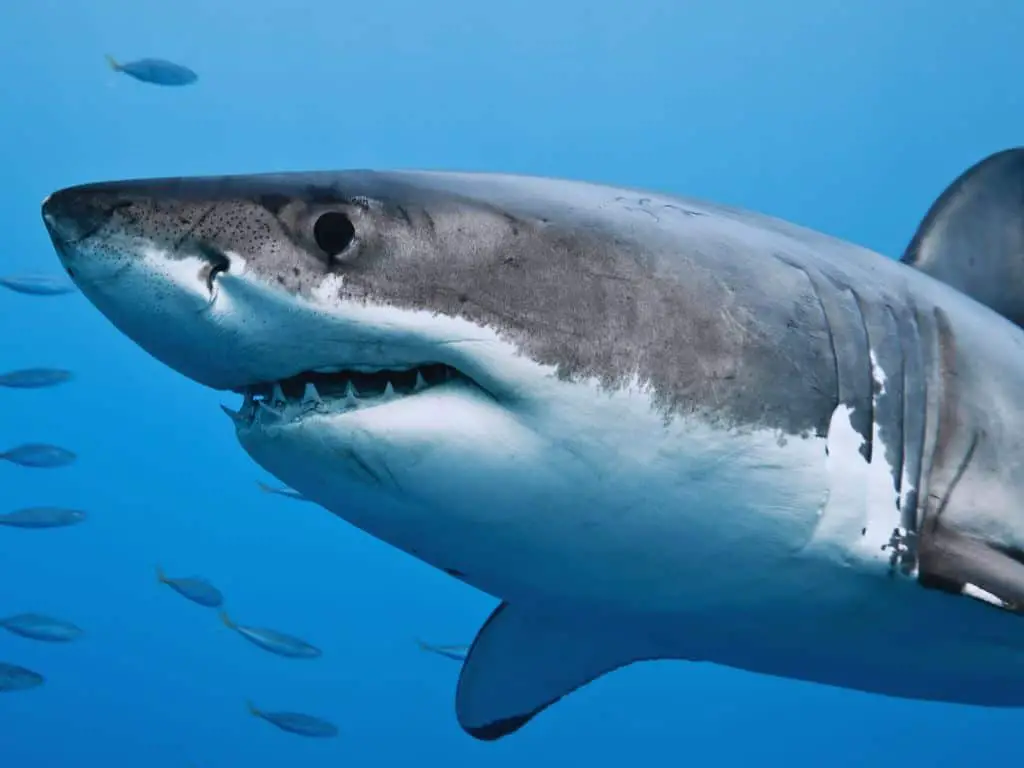On a recent trip to South Africa, I had the opportunity to cage dive with Great White Sharks, and looking at them, I couldn’t help but wonder how big Great White sharks could get.
The size and weight of the Great White Shark depend on the gender of the shark. Female Great White Sharks can grow up to 6.4 metres (21 feet), whereas males can grow up to 4 metres (13 feet) long. Most are smaller, however, with females measuring 4.6 to 4.9 metres (15 to 15 feet) and males generally measuring 3.4 to 4.0 metres (11 to 13 feet). Female Great White Sharks can weigh more than 1500kg, although males are much smaller.
My dive with them gave me so many questions that I wanted to know the answers to, so I spoke to the experts on board.did some further research when I returned to land.

Why is the female great white shark bigger?
The female Great White Shark is larger than the male because they need to be able to carry their young during pregnancy. This is common with all large ocean fish species, such as whales, as they need the extra girth to keep the unborn shark safe.
Females can be identified not just due to their size but also because they do not have a clasper which the male does.
What is the largest great white shark in history?
There have been many unconfirmed measurements of sharks throughout history. The Guinness Book of World Records listed two great white sharks as the largest, at 10.9 metres (36 feet) and 11.3 metres (37 feet), respectively.
The first was caught in the 1870s and one in the 1930s. Because the measurements were not obtained scientifically and because these specimens were so much larger than any great white previous or since researchers questioned these measurements.
In the 1970s, the jaws of the 10.9-metre shark caught in Port Fairy, Australia, were measured by John Randall, who found that the shark was approximately 5.0 metres (16.4 feet). The jaws are currently in the Natural History Museum in London.
It is thought that the 11.3-metre shark caught in the 1930s in New Brunswick, Canada, may have been mistaken as a great white and was a basking shark; however, due to the age of the capture of these sharks, it is likely to be a mystery that will ever be solved.
What is the largest shark caught by boat?
There have been two sharks caught that have been said to be larger than 6.1 metres. The first was caught off Kangaroo Island, Australia, in 1987 and nicknamed Kanga. The winch on the boat that should have lifted more than 4000 lbs would not raise the great white.
The crew decided to remove a three-meter section of the tail and dorsal fin, but the winch still wouldn’t lift the shark. They then decided to remove the head of the shark they bought aboard. With three of them, they still couldn’t move the head into a suitable position on the boat.
Peter Riseley, the Captain, said, “The head was higher than my waist, and I am six feet tall. It was four feet across. As the shark was never captured aboard in one piece, the actual weight and length were never documented, although the Captain said that he thought the length to be more than 7 metres (21 feet), which he compared to the size of the ship.
The shark’s jaws were measured at 0.91 metres (3 feet). A group of scientists estimated the length of sharks based on the overall dimensions of body parts such as the fins, jaws and teeth of 70 sharks. Their findings estimated that Kanga was between 15.1 feet and 23 feet.
However, the methods used drew criticism as the photographic evidence showed that the specimens were larger than previously used size estimates. The second team of scientists reviewed the case of Kanaga in 1996, conducting a morphometric analysis of the remains and examing the photographic evidence to validate the original size estimations. The scientist’s findings were consistent with the Captains and crew’s testimony.
What is the largest great white shark caught on film?
A great white called Deep Blue was caught on camera during Shark Week and is estimated to be around 6.1 meters (20 feet) long and weighs close to 5000 lbs. Deep Blue is a female estimated to be approximately 50 years old and has been spotted in Hawaii and Guadaloupe. It is believed that Deep Blue may have been pregnant when filmed, and this contributed to her size of 2.5 meters circumference.
Have we measured the largest great white shark?
It is improbable that the largest great white shark has been caught and measured. Dr Charlie Huveneers of Flinders University quoted, “It is quite conceivable that sharks larger than the scientifically confirmed maximum size exist. As for most species, scientists are unlikely to have measured the largest individual of that species, so it could be a possibility.”
Are Sharks Vertebrates? Unraveling the Ocean’s Apex Predators

How does the great white shark compare in size to other sharks?
The great white is approximately the same length as the Common Thresher shark but can outweigh it by almost three times. The Greenland shark can grow to 20 feet in length but generally only reaches1000 kgs in weight. The smallest shark is the Horn shark at 3.9 feet, and the largest is the Whale shark at 41 feet in length and a weight of 21000 kgs.
How do these compare to the sharks in the Jaws movies?
The Jaws movies are based on books by author Peter Brenchley, and in the first novel, he first states that the shark must be twenty feet long with a head four feet across.
In the first Jaws movie, this is increased to twenty-five feet and three tons in weight.
In the second novel, the shark was written as thirty feet long and two tons in weight, whereas, in the movie, it is said ‘to have been a shark of considerable size.’
In Jaws 3-D, the shark is now the largest at 35 feet, while in the fourth movie, Jaws: The Revenge, the size had decreased to 28 feet and a weight of three thousand pounds.
Are there any natural predators to the great white shark?
The great white shark’s only predator is, on occasion, the Killer Whale and, unfortunately, man. In 2017, five great white carcasses were washed up on South African beaches. All of them had a hole running down their livers and pectoral fin.
A team of killer whales had been spotted in the area when the sharks were found dead. Although killer whales in Antarctica feed on minke whales and Orcas in North America focus on fish, the killer whales in South Africa pluck out the high-energy liver, leaving the rest of the carcass for other animals.

